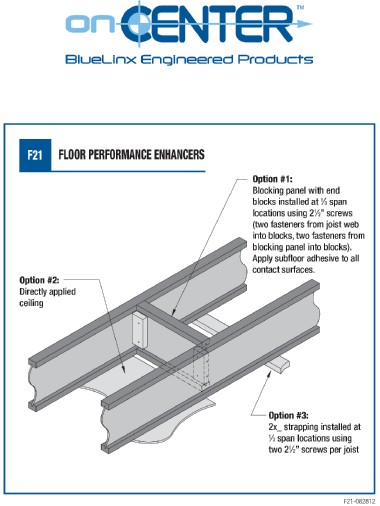I-joist Floor Performance
I-joist Floor Performance
From time to time we get complaints about floor performance in situations where everything looks good on paper. These can be a bit puzzling in some cases. Typically the floor is designed to support the load adequately, but there is a little bounce or vibration in the floor if the conditions are right. The software doesn’t have a way of measuring or predicting this. Some people recommend stricter deflection criteria or thicker floor sheathing, which may or may not help. We have learned that in many cases it simply starts with adequately bracing the bottom of the joists.
Think about 2X10 floor joists for a minute. Code requires you to install a row of bridging to brace the bottom of them from moving back and forth. Now think about floor truss systems for a minute. Code requires you to put a row of 2X6 strongback material every 10′, which braces the bottom of them. Now if you think about I-joist floor systems, many believe that the bottom chord does not need any bracing. What you end up with is a 2X3 bottom chord spanning up to 20′ without anything to keep it from moving back and forth. (assuming the basement isn’t drywalled) This seems to be a common cause for performance concerns. This allows the bottom chord to try to “get out of the way” when the joists starts deflecting.
So what do we do?
Bluelinx/On Center has the attached “F21 Floor Performance Enhancer” detail in their product guide to address this very issue. It gives you 3 options. Blocking between joists, drywall the bottom of the joists, or install 2X4 strapping across the bottom of the joists. You may not realize it but we put this detail on every one of our I-joist layouts. Take a look. However, it is a recommendation, not a requirement necessarily, so most people tend to ignore it, or don’t notice it. Please start educating your customers on this. If they are going to finish the basement it is a non-issue. This tends to be more of an issue when the basement is left untouched. In this case we recommend the 2X4 strapping solution, since it is less labor-intensive than the blocking, and the 2X4’s can be removed down the road when they drywall the ceiling.

But does it really help?
We have received positive feedback from the field when the 2X4 strapping was installed. But obviously there is no great way to measure the improvement, since much of it is just based on “feeling it out.”
Experiment:
I was also curious how much this would help, so I did an experiment in my own home this weekend. My house was built in 2009. My floor joists are 40 series 11 7/8″ at 16″ o/c. Under the great room is an 18′-2″ clear span, and part of a multi-span condition. Very common scenario. These joists perform very well on paper: Live Load L/869 = .26″ & Total Load L/644 = .35″. A copy of the joist calc is attached. Yet, something as simple as my dog pacing through the great room can create some bounce in the floor. I can often feel it when somebody walks through the room.
Like many people, I didn’t install any bracing under or in my I-joists, and my basement is unfinished. I decided to install 2 rows of 2X4 bracing in this weekend to see how it would change. I installed the 2X4’s at the 1/3 span locations. I used (2) 2 1/2″ screws per joist as the detail states, and ran them from treated sill to treated sill. A picture of the finished product is attached.
Result? – It helped. No, my floor doesn’t feel like concrete yet, and never will, but it certainly has more rigidity to it and was fairly noticeable the first time I walked through the room.

Evidence….
Before I did this, I was trying to think of a way to test how much improvement it would make, and possibly a way to measure it. Well, I didn’t have any scientific way to measure it, but I tried the Jurassic Park/T-rex water ripple test. And I videotaped the before and after. I put a chair in the middle of the floor, and a glass of water on that chair. I first walked past the chair, and then stood next to the chair and rocked back and forth.
After watching the videos I noticed that it isn’t really the water that tells the story, because water ripples so easily, it’s actually the edge of the chair. If you watch the edge of the chair in relation to the other furniture, you can see the movement. The first video shows a little bit more movement, especially when just walking past the chair. The second video had much less movement when walking past the chair, but still a little movement when I rocked back and forth
Here are the videos. You have to watch pretty close to notice the difference….
Before 2X4 strapping was installed:
After 2X4 strapping was installed:

